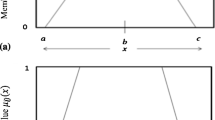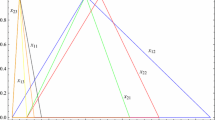Abstract
The classical methods for solving fuzzy equations are very limited because, often, there are no solutions or very strong conditions for the equations it is placed to have a solution. In addition, the solution’s support obtained in these methods is large. All of this is due to the consideration of operations related to equations based on the principle of extension, which is due to the absence of ineffective members. These high points are our motive for achieving a new approach to solving fuzzy equations. We will solve the fuzzy equations, taking into account the fuzzy operations involved in the equation based on the transmission average by Abbasi et al. (J Intell Fuzzy Syst 29:851–861, 2015). In this paper, a computational procedure is proposed to solve the fuzzy equations that meets the defects of previous techniques, specially reluctant to question whether the answer is valid in the equation. The proposed approach is implemented on the fuzzy equations as \(AX+B=C\), \(AX^{2}+BX+C=D\), \(AX^{3}+BX^{2}=CX\) . At the end, it is shown that the solution of the proposed method in comparison with other methods of solving fuzzy equations are more realistic, that is, they have smaller support.




Similar content being viewed by others
References
Abbasi F, Allahviranloo T, Abbasbandy S (2015) A new attitude coupled with fuzzy thinking to fuzzy rings and fields. J Intell Fuzzy Syst 29:851–861
Allahviranloo T, Perfilieva I, Abbasi F (2018) A new attitude coupled with fuzzy thinking for solving fuzzy equations. Soft Comput 22(9):3077–3095
Biacino L, Lettieri A (1989) Equation with fuzzy numbers. Inf Sci 47(1):63–76
Buckley JJ (1992) Solving fuzzy equations. Fuzzy Sets Syst 50(1):1–14
Buckley JJ, Qu Y (1990) Solving linear and quadratic equations. Fuzzy Sets Syst 38(1):48–59
Buckley JJ et al (1997) Solving fuzzy equations using neural nets. Fuzzy Sets Syst 86:271–278
Buckley JJ et al (2002) Solving fuzzy equations using evolutionary algorithms and neural nets. Soft Comput 6:116–123
Dubois D, Prade H (1984) Fuzzy set theoretic differences and inclusions and their use in the analysis of fuzzy equations. Control Cybern (Warshaw) 13:129–146
Jiang H (1986) The approach to solving simultaneous linear equations that coefficients are fuzzy numbers. J Natl Univ Defence Technol (Chin) 3:96–102
Kawaguchi MF, Date T (1993) A calculation method for solving fuzzy arithmetic equation with triangular norms. In: Proceedings of 2nd IEEE international conference on fuzzy systems (FUZZY-IEEE), San Francisco, pp 470–476
Klir GJ, Yuan B (1995) Fuzzy sets and fuzzy logic: theory and applications. Prentice-Hall PTR, Upper Saddlie River
Mazarbhuiya FA et al (2011) Solution of the fuzzy equation \({\text{ A }}+{\text{ X }}={\text{ B }}\) using the method of superimposition. Appl Math 2:1039–1045
Sanchez E (1984) Solution of fuzzy equations with extend operations. Fuzzy Sets Syst 12:273–248
Wang X, Ha M (1994) Solving a system of fuzzy linear equations. In: Delgado M, Kacpryzykand J, Verdegay JL, Vila A (eds) Fuzzy optimisation: recent advances. Physica, Heildelberg, pp 102–108
Wasowski J (1997) On solutions to fuzzy equations. Control Cybern 26:653–658
Zhao R, Govind R (1991) Solutions of algebraic equations involving generalised fuzzy number. Inf Sci 56:199–243
Zadeh LA (1975) The concept of a linguistic variable and its application to approximate reasoning—part I, II, III. Inf Sci
Acknowledgements
The authors are grateful to anonymous referees whose valuable comments helped to improve the content of this paper.
Author information
Authors and Affiliations
Corresponding author
Ethics declarations
Conflict of interest
F. Abbasi declares that he has no conflict of interest. T. Allahviranloo declares that he has no conflict of interest.
Ethical approval
This article does not contain any studies with human participants performed by any of the authors.
Additional information
Communicated by V. Loia.
Publisher's Note
Springer Nature remains neutral with regard to jurisdictional claims in published maps and institutional affiliations.
Rights and permissions
About this article
Cite this article
Abbasi, F., Allahviranloo, T. Computational procedure for solving fuzzy equations. Soft Comput 25, 2703–2717 (2021). https://doi.org/10.1007/s00500-020-05330-8
Published:
Issue Date:
DOI: https://doi.org/10.1007/s00500-020-05330-8




